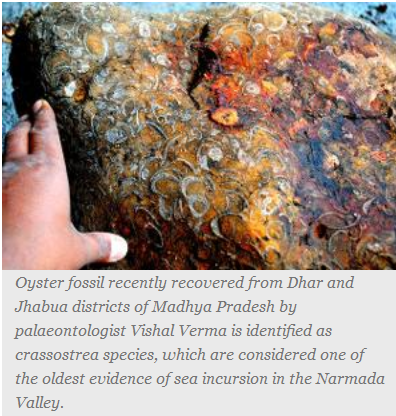Dhar, MP
These are newspaper articles selected for the excellence of their content.
|
Marine life and sea
86 million-year-old oyster fossil found in Dhar
Bagish Jha,TNN | Mar 8, 2015 The Times of India
INDORE: Discovery of around 86 million-year-old fossil of a rare species of oyster, has once again re-confirmed the presence of marine life and sea in central India.
Oyster fossil recently recovered from Dhar and Jhabua districts of Madhya Pradesh by palaeontologist Vishal Verma is identified as crassostrea species, which are considered one of the oldest evidence of sea incursion in the Narmada Valley. "Large numbers of good quality marine molluscs as oysters and gastropods are present in the matrix of fossils. It is one of the best quality samples found from Nimar sandstone of Bagh beds," said Vishal Verma, adding sediments of this sea arm is defined as Bagh Beds and oyster fossils discovered from here belong to first upper cretaceous age (from 140 to 65 million years ago).
Verma said fossils was discovered when was carrying out fieldwork for the proposed National Dinosaur Fossil Park to be set up in Dhar district. He said this is not the first time evidence of marine life and sea was found in this region. "In 2012, we discovered around 6.5 crore years to more than 10 crore-year-old fossilized teeth and bones of three generations of shark at Bagh belt in Dhar," said Verma, who discovered several dinosaur fossils from the region.
Assistant professor of Howrah College of Engineering, Tapas Gangopadhya, who had done extensive work on fossils of the region, said he too had found fossil of shark's predecessor at Bagh Belt around few years back. "The fossils of star fish and other marine life discovered here are yet to be identified as most of them are extinct. They were considered to be the earliest species of life. Fossils of shark and many other species have also been found which suggest the area was under sea," he said. The Narmada valley is very rich in fossils, but unfortunately they were not being preserved, he added.
Ashok Sahani, senior scientist of Centre for Advance Study in Geology and an internationally acclaimed authority on fossils, said Narmada Valley fossils can unravel myths about the evolution and civilization. A thorough research would also challenge the existing theory of evolution. Proper and extensive research may unfold the mystery." The rarest and most significant is the inter-trappian fossil which, if studied properly, can throw light on early life on earth.
